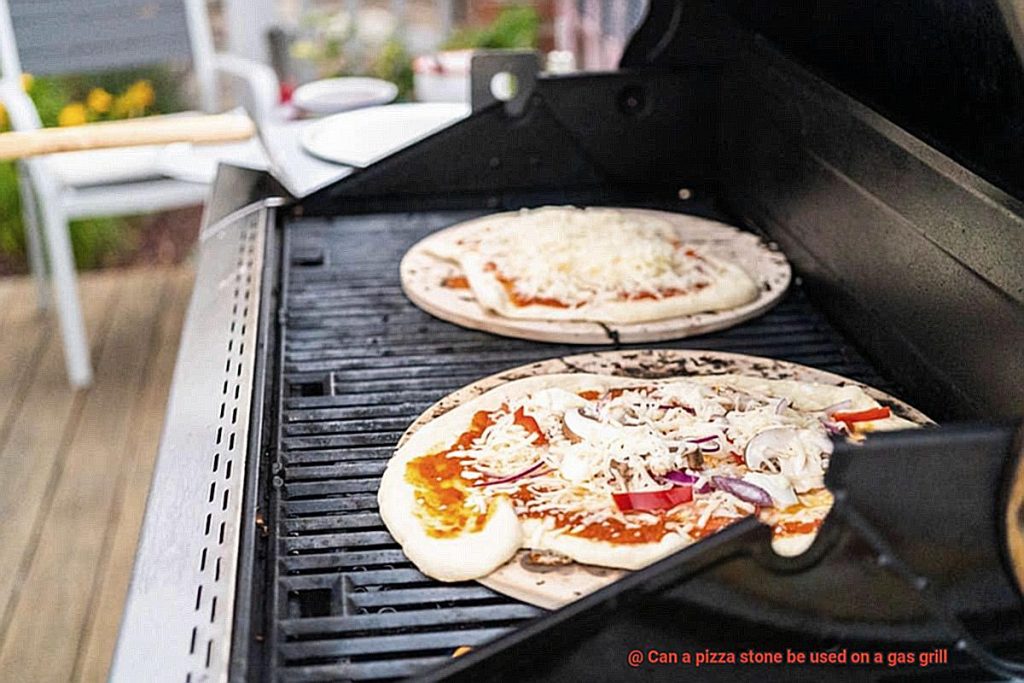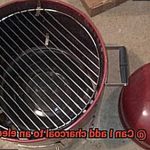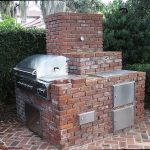Imagine this: it’s a warm summer night, and you’re itching for some mouth-watering homemade pizza cooked to perfection on the grill. You’ve got your toppings all set and your dough is rising, but there’s one nagging question – can you use a pizza stone on a gas grill?
This query has left many home cooks scratching their heads in confusion. Although we all know that a pizza stone is essential for creating crispy, delicious pizza in the oven, using it on a gas grill may not seem like an obvious choice.
But don’t fret. I’m here to share with you that using a pizza stone on a gas grill is not only feasible but also surprisingly simple. In fact, grilling pizza on a stone can yield better outcomes than baking it in the oven.
In this blog post, we’ll delve into the nitty-gritty of utilizing a pizza stone on a gas grill. We’ll explore the perks of grilling pizza on a stone, how to safely use a pizza stone on a gas grill, and some tricks for achieving the ultimate grilled pizza experience. By the end of this post, you’ll be well-equipped to dazzle your loved ones with your outdoor cooking prowess. So let’s dive right in.
Contents
What is a Pizza Stone?
What exactly is a pizza stone? It’s a flat, circular piece of ceramic or cordierite material that is designed to bake pizza in the oven. By heating up the stone to a high temperature and then placing your pizza on top, you create the ideal environment for cooking up a mouth-watering pizza with a crispy crust.
Pizza stones are loved by both home cooks and professional chefs because they evenly absorb and distribute heat, resulting in deliciously cooked pizzas every time. They also help to draw moisture away from the dough, which prevents the crust from becoming soggy.
But did you know that pizza stones aren’t limited to just baking pizzas? You can also use them to bake bread, cookies, and even vegetables. Some adventurous cooks even use pizza stones on the grill to cook steak and seafood to perfection.
It’s important to choose a high-quality pizza stone made from ceramic or cordierite materials. Cheaper options like clay or stone can easily crack or break, while high-quality materials distribute heat more evenly and effectively.
If you’re wondering whether you can use a pizza stone on your gas grill, the answer is yes. Just make sure to choose a stone specifically designed for grilling and ensure that your grill can reach temperatures of at least 500°F.
Can You Use a Pizza Stone on a Gas Grill?
Pizza is a beloved food that can be cooked in a variety of ways. However, if you’re looking for a delicious, crispy pizza with an even cook, using a pizza stone is the way to go. The good news is that you can use a pizza stone on your gas grill. But before you get started, there are some precautions you need to take.
Firstly, make sure that your pizza stone is safe for use on a grill. Not all pizza stones are created equal, and some may crack or break if exposed to direct heat from a gas grill. Check the manufacturer’s instructions to see if your pizza stone is safe for use on a grill or if it’s designed only for use in an oven.
Once you’ve got a safe pizza stone, it’s time to clean your gas grill thoroughly. Grease and residue on the grill grates can cause flare-ups and result in burnt or unevenly cooked pizza. Give your grill a good scrub down and ensure that the grates are free from any debris.
Now it’s time to preheat your pizza stone. This step is essential to ensure that your pizza cooks evenly. Simply place the pizza stone on the grill grates and turn on the burners to high heat. Let the stone heat up for at least 30 minutes before placing your pizza on it.
When it comes time to cook your pizza, keep an eye on it to make sure it doesn’t burn. You can also rotate the pizza stone halfway through cooking to ensure even cooking. And don’t forget to let your pizza rest for a few minutes before slicing into it.
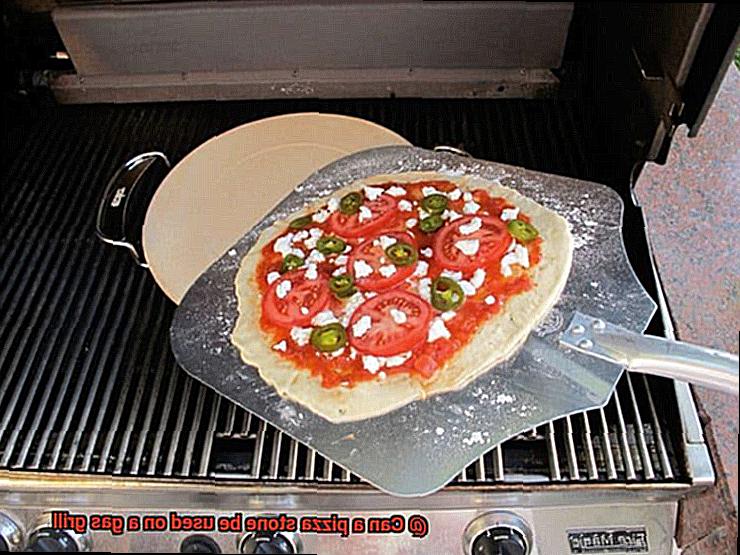
Choosing the Right Type of Pizza Stone for Your Gas Grill
As an expert in this field, I’ve done some research and compiled a list of factors to consider when choosing the right type of pizza stone for your gas grill.
Firstly, let’s talk about materials. You have a few options to choose from, including ceramic, clay, and cordierite. If quick and even heating is what you’re looking for, go for ceramic stones. However, handle them gently as they can crack easily. Clay stones are also great for even heating but require preheating before use. If durability is your priority, cordierite stones can withstand high temperatures without cracking.
Size matters too. Choose a stone that fits your gas grill properly with some space around the edges for air circulation. A stone that is too small may not cook the pizza evenly, while a stone that is too large may be difficult to handle.
Lastly, the thickness of your pizza stone plays a crucial role in producing a crispy crust. Thicker stones tend to hold heat better and produce a crispier crust, while thinner stones may cook the pizza faster but may not provide as much heat retention.
To sum it up, when choosing a pizza stone for your gas grill, consider the material, size, and thickness to ensure a perfectly cooked pizza every time. Here’s a quick recap:
- Ceramic: Quick and even heating but handle with care
- Clay: Even heating but requires preheating
- Cordierite: Durable and withstands high temperatures
- Choose the right size for proper air circulation
- Thicker stones produce crispier crusts
Considerations for Heat Source and Size of Your Pizza Stone
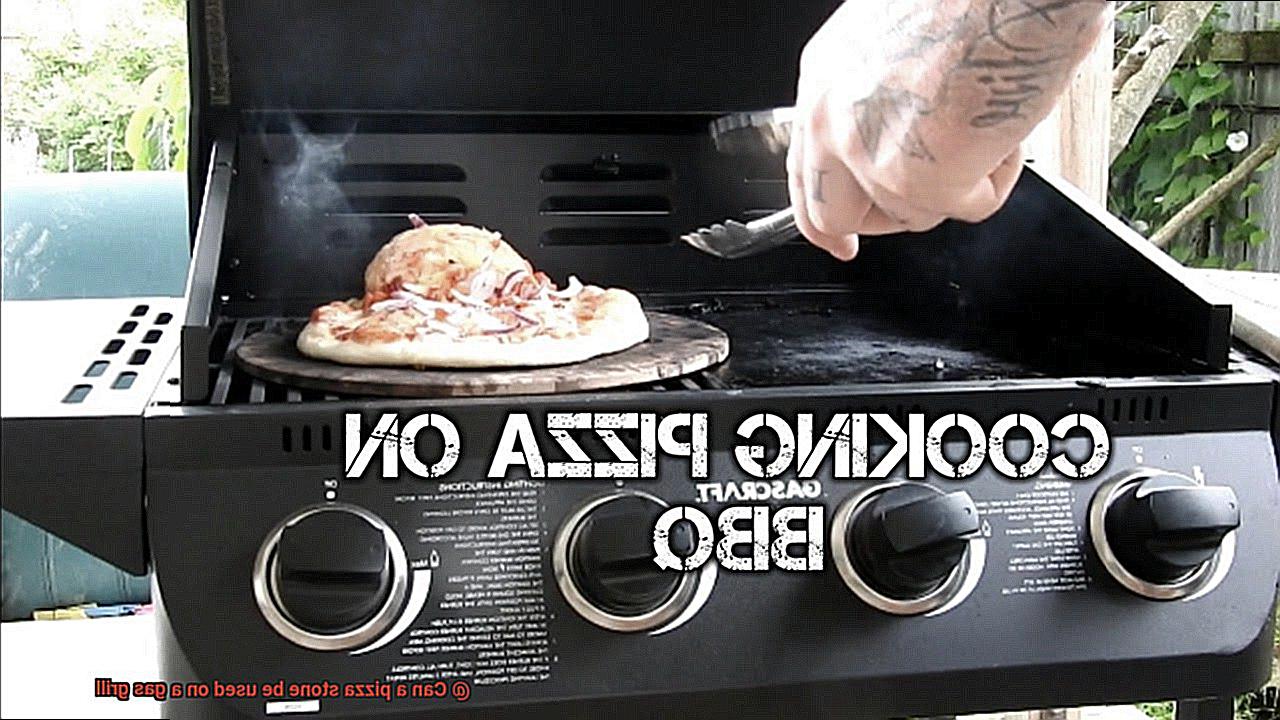
Consider using a pizza stone on your gas grill. However, before you start, it’s important to keep two critical factors in mind: the heat source and size of your pizza stone.
Firstly, let’s talk about the heat source. Gas grills are known for producing an even heat, making them perfect for use with a pizza stone. However, make sure your gas grill is capable of reaching high enough temperatures to cook pizza correctly.
While most gas grills can reach temperatures between 500-600 degrees Fahrenheit, investing in a higher-end gas grill that can reach temperatures of 700-800 degrees Fahrenheit is ideal for cooking pizza to perfection. Keep in mind that factors such as weather and the amount of food being cooked can affect the temperature of your grill. So, keep an eye on the temperature gauge to ensure it stays consistent throughout the cooking process.
Now, let’s talk about pizza stone size. Choosing the right size is crucial to ensure your pizza cooks evenly and thoroughly. A pizza stone that’s too small may not accommodate larger pizzas or multiple pizzas at once. Conversely, a pizza stone that’s too large may not fit on your grill or allow enough space for air to circulate around the food.
For best results, choose a pizza stone that’s slightly smaller than the cooking surface of your grill. This will allow some space around the edges for air to circulate and prevent any hot spots from developing.
Preparing the Pizza Stone Before Grilling
Before you get started, it’s important to prepare the pizza stone properly to ensure even cooking and prevent any cracking. As an expert in this topic, I’ve got you covered with the following steps:
Step 1: Clean the Pizza Stone
The first step in preparing your pizza stone is to give it a good cleaning. Use warm water and a brush to remove any debris or residue from previous uses. This will ensure that your pizza is free from any unwanted flavors or odors.
Step 2: Season the Pizza Stone
To achieve a perfectly cooked crust, it’s crucial to season your pizza stone. This involves coating the surface of the stone with a thin layer of oil. You can use vegetable or olive oil for this step. Make sure to apply the oil evenly across the surface of the stone and let it sit for about an hour. This process allows the oil to penetrate the surface and create a non-stick surface that will help you achieve that crispy crust we all love.
Step 3: Preheat the Pizza Stone
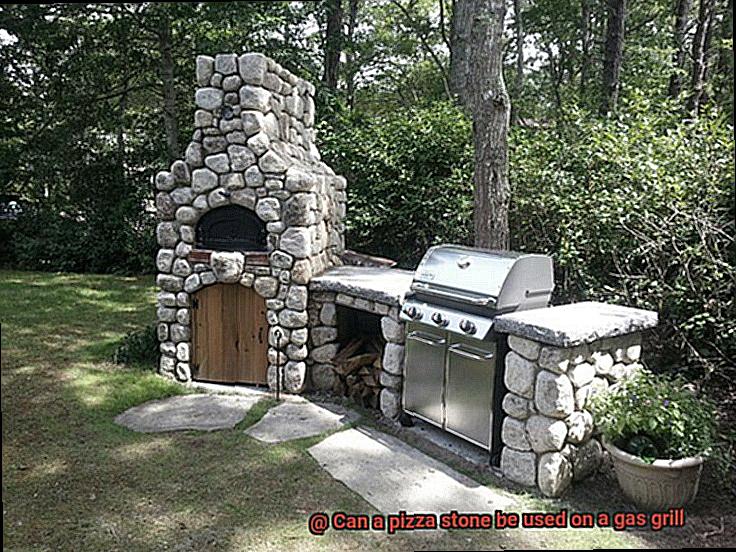
Before adding any food to the pizza stone, it’s important to preheat it on your gas grill. Place the pizza stone on the grill grates and turn on the heat to high. Allow the stone to heat up for at least 30 minutes before adding your pizza. This ensures that the pizza cooks evenly and doesn’t stick to the stone.
Step 4: Keep it Clean
While grilling on your pizza stone, be sure to keep it clean. Use a scraper or brush to remove any excess food or grease immediately. After grilling, allow the pizza stone to cool completely before cleaning it with warm water and a brush. Avoid using soap as this can cause the pizza stone to absorb unwanted flavors.
Tips for Grilling with a Pizza Stone on a Gas Grill
Grilling with a pizza stone on a gas grill can give you that crispy crust and perfectly melted cheese that will make your taste buds sing. Follow these steps for a delicious homemade pizza every time.
Check Your Pizza Stone
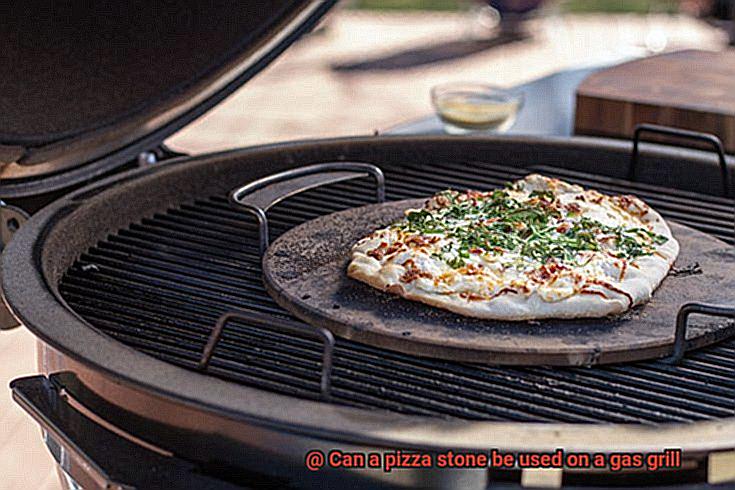
Before you start, make sure your pizza stone is compatible with a gas grill. Not all stones can handle the high heat of a gas grill, so be sure to check the manufacturer’s instructions. Also, make sure your stone is properly seasoned before using it for the first time.
Preheat Your Grill and Stone
Preheating your grill and stone for at least 30 minutes before cooking is crucial. This ensures that the stone is evenly heated and helps prevent the pizza from sticking. Don’t rush this step – proper preheating is key to a good pizza.
Use a Pizza Peel
When placing the pizza on the stone, use a pizza peel dusted with cornmeal or flour to prevent sticking. This also makes it easier to slide the pizza onto the stone without burning your hands. It’s important not to overload the pizza with toppings, as this can cause it to become soggy.
Cook Over Indirect Heat
Cook your pizza over indirect heat, with the burners on one side and the stone on the other. This allows for even cooking and prevents burning. Keep an eye on your pizza and rotate it as necessary to ensure even cooking.
Let It Rest
Once your pizza is done, let it rest for a few minutes before slicing into it. This prevents the cheese from sliding off and allows the crust to set properly. Then, slice and serve your delicious homemade pizza.
Pros and Cons of Using a Pizza Stone on a Gas Grill
A pizza stone might be the answer. However, as with any kitchen gadget, there are pros and cons to consider.
Let’s start with the positives. Firstly, a pizza stone creates a crispy crust by absorbing moisture from the dough, resulting in an even bake. Secondly, heat is evenly distributed when using a pizza stone, ensuring your pizza cooks evenly without burnt spots. But wait, there’s more. Pizza stones aren’t just for pizza – they can also be used for bread and other dishes, adding versatility to your cooking arsenal. Plus, they’re relatively inexpensive and easy to maintain.
On the downside, pizza stones can crack if exposed to sudden temperature changes or dropped accidentally. They also take longer to preheat than the grill itself, meaning extra time is required for preheating before placing your pizza on the stone. Additionally, pizza stones come in limited sizes, so larger pizzas or multiple pies may not be possible. Finally, cleaning can be difficult as soap or detergent cannot be used due to odors and flavors being absorbed.
zgCvbDfIOuE” >
Conclusion
In conclusion, the answer to whether a pizza stone can be used on a gas grill is a resounding yes. Not only does it make for perfectly cooked pizzas with crispy crusts, but it’s also an essential tool for any pizza lover. However, choosing the right pizza stone is crucial to achieving optimal results.
When selecting a pizza stone for your gas grill, consider the material, size, and thickness. Once you have your stone, ensure that it’s safe for use on a grill and properly seasoned before use. Preheat both the grill and the stone to prevent sticking and ensure even heat distribution.
While there are some potential downsides to using a pizza stone on a gas grill such as cracking and longer preheating times, these are outweighed by its benefits. A pizza stone adds versatility to your outdoor cooking experience and can be used for more than just pizzas.
By following these tips and tricks, you’ll be well-equipped to impress your family and friends with delicious homemade grilled pizzas all summer long.

